Fatigue Life Estimation of Pressurized Pipelines Using XFEM: Elastic vs. Plastic Regimes
Abstract
1. Introduction
2. XFEM Formulation
3. Methodological Approach
3.1. Material and Geometry
3.2. Mesh Selection
3.3. Test Tables
4. Results and Discussion
4.1. Model Validation
4.2. Fatigue Behavior in Elastic Regime
4.3. Fatigue Behavior in Elastoplastic Regime
4.4. Fatigue Life Estimation in the Elastic and Plastic Regimes
5. Conclusions
Author Contributions
Funding
Data Availability Statement
Conflicts of Interest
References
- Hu, J.; Wang, Q.; Zhang, Y.; Meng, Z.; Zhang, J.; Fan, J. Numerical and Experimental Study on the Process of Filling Water in Pressurized Water Pipeline. Water 2023, 15, 2508. [Google Scholar] [CrossRef]
- Wu, J.; Wan, L.; Liu, H.; Liu, H.; Liang, B.; Ai, S.; Long, M. Fatigue Life Simulation of High-Pressure Injection-Production Pipeline Based on nCode DesignLife. Steel Res. Int. 2025, 96, 2400624. [Google Scholar] [CrossRef]
- Zhang, L.; Jiang, B.; Zhang, P.; Yan, H.; Xu, X.; Liu, R.; Tang, J.; Ren, C. Methods for fatigue-life estimation: A review of the current status and future trends. Nanotechnol. Precis. Eng. 2023, 6, 2. [Google Scholar] [CrossRef]
- Bencherif, N.; Slamene, A.; Hamza, B.; Trari, I.I.; Boudaib, I.; Mokhtari, M. Predictive plasticity unveiled: XFEM modeling of cyclic failure in pressurized straight pipelines under three-point bending. Mech. Based Des. Struct. Mach. 2025, 53, 3547–3571. [Google Scholar] [CrossRef]
- Kim, J.-S.; Kim, J.-Y. An efficient simplified elastic–plastic analysis procedure using engineering formulae for strain-based fatigue assessment of nuclear safety class 1 piping system subjected to severe seismic loads. Int. J. Fatigue 2021, 151, 106390. [Google Scholar] [CrossRef]
- Sager, R.; Curiel, F.; Holliday, C. Key Considerations for Elastic Finite-Element Modeling of Pipeline Dents for Fatigue Assessments. In Proceedings of the International Pipeline Conference, American Society of Mechanical Engineers, Calgary, AB, Canada, 26–30 September 2022. [Google Scholar]
- Wang, Z.; He, W.; Li, X.; Lu, T.; Chen, S.; Li, D.; Zheng, H. Phase field modelling of elastic-plastic fatigue fracture of oil and gas pipeline. Mater. Res. Express 2024, 11, 085504. [Google Scholar] [CrossRef]
- Bartaula, D.; Li, Y.; Koduru, S.; Adeeb, S. Simulation of fatigue crack growth using XFEM. In Proceedings of the Pressure Vessels and Piping Conference, American Society of Mechanical Engineers, Virtual, 3 August 2020. [Google Scholar]
- Gholami, H.; Shahrooi, S.; Shishehsaz, M. Strain-based fatigue life analysis of pipelines with external defects under cyclic internal pressure. J. Strain Anal. Eng. Des. 2021, 56, 313–326. [Google Scholar] [CrossRef]
- Mansor, N.I.I.; Abdullah, S.; Ariffin, A.K.; Syarif, J. A review of the fatigue failure mechanism of metallic materials under a corroded environment. Eng. Fail. Anal. 2014, 42, 353–365. [Google Scholar] [CrossRef]
- Joseph, S.H.; Leevers, S. Failure mechanics of uPVC cyclically pressurized water pipelines. J. Mater. Sci. 1985, 20, 237–245. [Google Scholar] [CrossRef]
- Kim, W.S. Fatigue Life Evaluation for the Repair Methods of High Pressure Gas Pipeline. In Proceedings of the International Conference on Offshore Mechanics and Arctic Engineering, American Society of Mechanical Engineers, Glasgow, UK, 9–14 June 2019. [Google Scholar]
- Wang, Y.; Javadi, A.A.; Fidelibus, C.; Liang, H. Improvements for the solution of crack evolution using extended finite element method. Sci. Rep. 2024, 14, 26924. [Google Scholar] [CrossRef] [PubMed]
- Deng, Q.-Y.; Zhu, S.-P.; He, J.-C.; Li, X.-K.; Carpinteri, A. Multiaxial fatigue under variable amplitude loadings: Review and solutions. Int. J. Struct. Integr. 2022, 13, 349–393. [Google Scholar] [CrossRef]
- Alshoaibi, A.M.; Fageehi, Y.A. A computational framework for 2D crack growth based on the adaptive finite element method. Appl. Sci. 2022, 13, 284. [Google Scholar] [CrossRef]
- Salmi, H.; Hachim, A.; El Bhilat, H.; El Had, K. Crack influence on a pipe with double slope under internal pressure: Numerical simulation with XFEM. IIUM Eng. J. 2020, 21, 266–283. [Google Scholar] [CrossRef]
- Merle, R.; Dolbow, J. Solving thermal and phase change problems with the extended finite element method. Comput. Mech. 2002, 28, 339–350. [Google Scholar] [CrossRef]
- Rahman, S.; Ghadiali, N.; Wilkowski, G.M.; Moberg, F.; Brickstad, B. Crack-opening-area analyses for circumferential through-wall cracks in pipes—Part III: Off-center cracks, restraint of bending, thickness transition and weld residual stresses. Int. J. Press. Vessel. Pip. 1998, 75, 397–415. [Google Scholar] [CrossRef]
- Kanth, S.A.; Harmain, G.A.; Jameel, A. Investigation of fatigue crack growth in engineering components containing different types of material irregularities by XFEM. Mech. Adv. Mater. Struct. 2022, 29, 3570–3587. [Google Scholar] [CrossRef]
- Yue, J.; Noda, N.; Ono, K. Effect of Cracks Shape on the Stress Intensity Factor for Cracks near a Bimaterial Interface. J.-Soc. Mater. Sci. Jpn. 2005, 54, 1060. [Google Scholar] [CrossRef]
- Li, Y.; Nagashima, T.; Nagai, M.; Shinko, T.; Miura, N. Fatigue crack propagation analysis using XFEM for cladded C (T) specimens and its validation. Mech. Eng. J. 2024, 11. [Google Scholar] [CrossRef]
- Kim, N.H.; Oh, C.S.; Kim, Y.J.; Kim, J.S.; Jerng, D.W.; Budden, J. Limit loads and fracture mechanics parameters for thick-walled pipes. Int. J. Press. Vessel. Pip. 2011, 88, 403–414. [Google Scholar] [CrossRef]
- Montassir, S.; Yakoubi, K.; Moustabchir, H.; Elkhalfi, A.; Rajak, D.K.; Pruncu, C.I. Analysis of crack behaviour in pipeline system using FAD diagram based on numerical simulation under XFEM. Appl. Sci. 2020, 10, 6129. [Google Scholar] [CrossRef]
- Yakoubi, K.; Montassir, S.; Moustabchir, H.; Elkhalfi, A.; Pruncu, C.I.; Arbaoui, J.; Farooq, M.U. An extended finite element method (XFEM) study on the elastic t-stress evaluations for a notch in a pipe steel exposed to internal pressure. Mathematics 2021, 9, 507. [Google Scholar] [CrossRef]
- Barkaoui, A.; El Moussaid, M.; Moustabchir, H. Numerical modelling and comparison of SIF in pipelines exposed to internal pressure with longitudinal crack using XFEM method. Appl. Comput. Sci. 2025, 21, 31–43. [Google Scholar] [CrossRef]
- Moustabchir, H.; Pruncu, C.I.; Azari, Z.; Hariri, S.; Dmytrakh, I. Fracture mechanics defect assessment diagram on pipe from steel P264GH with a notch. Int. J. Mech. Mater. Des. 2016, 12, 273–284. [Google Scholar] [CrossRef]
- Yu, M.-C.; Pan, W.-F. Failure of elliptical tubes with different long–short axis ratios under cyclic bending in different directions. Metals 2023, 13, 1891. [Google Scholar] [CrossRef]
- Wang, L.-X.; Wen, L.-F.; Tian, R.; Feng, C. Improved XFEM (IXFEM): Arbitrary multiple crack initiation, propagation and interaction analysis. Comput. Methods Appl. Mech. Eng. 2024, 421, 116791. [Google Scholar] [CrossRef]
- Khan, M.A.; Singh, S.S.K.; Abdullah, S.; Arifin, A.; Bashir, M. Fatigue life characterisation of API X65 steel pipeline for internal vibrational loads under sea water condition. Appl. Ocean. Res. 2025, 155, 104454. [Google Scholar] [CrossRef]
- Khakifirooz, M.; Fathi, M.; Lee, I.-C.; Tseng, S.-T. Neural ordinary differential equation for sequential optimal design of fatigue test under accelerated life test analysis. Reliab. Eng. Syst. Saf. 2023, 235, 109242. [Google Scholar] [CrossRef]
- Atanasiu, C.; Sorohan, Ş. Researches on the distribution of stresses in a wall girder with geometrical discontinuities. IOP Conf. Ser. Mater. Sci. Eng. 2020, 997, 012095. [Google Scholar] [CrossRef]
- Steinhoff, S.; Röscher, S.; Knobloch, M. Towards an advanced fatigue assessment of welded steel joints with multiaxial stress states. Ce/papers 2023, 6, 2589–2594. [Google Scholar] [CrossRef]
- McMeeking, R.M. Finite deformation analysis of crack-tip opening in elastic-plastic materials and implications for fracture. J. Mech. Phys. Solids 1977, 25, 357–381. [Google Scholar] [CrossRef]
- Cheng, L.; Yu, Z.; Liu, X. Elastoplastic Constitutive Model for Energy Dissipation and Crack Evolution in Rocks. Appl. Sci. 2025, 15, 4179. [Google Scholar] [CrossRef]


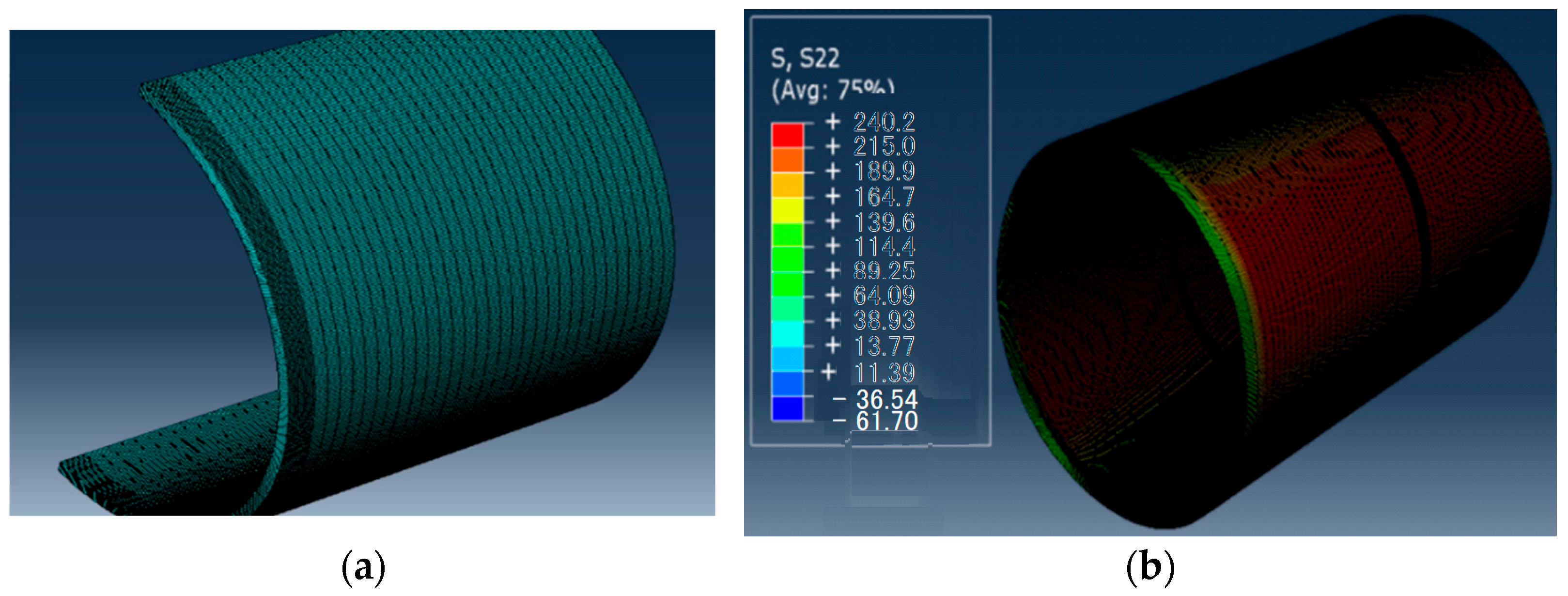
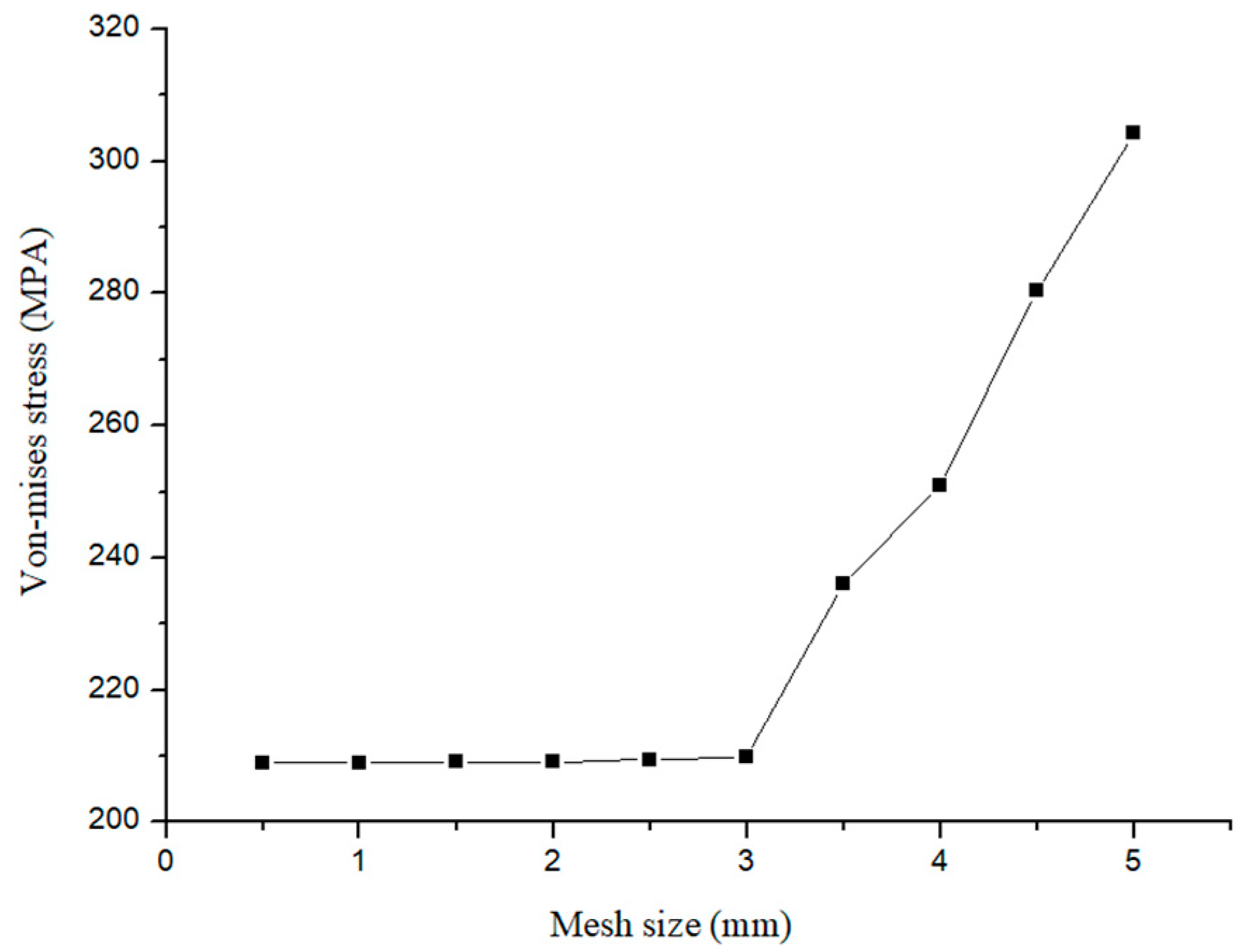
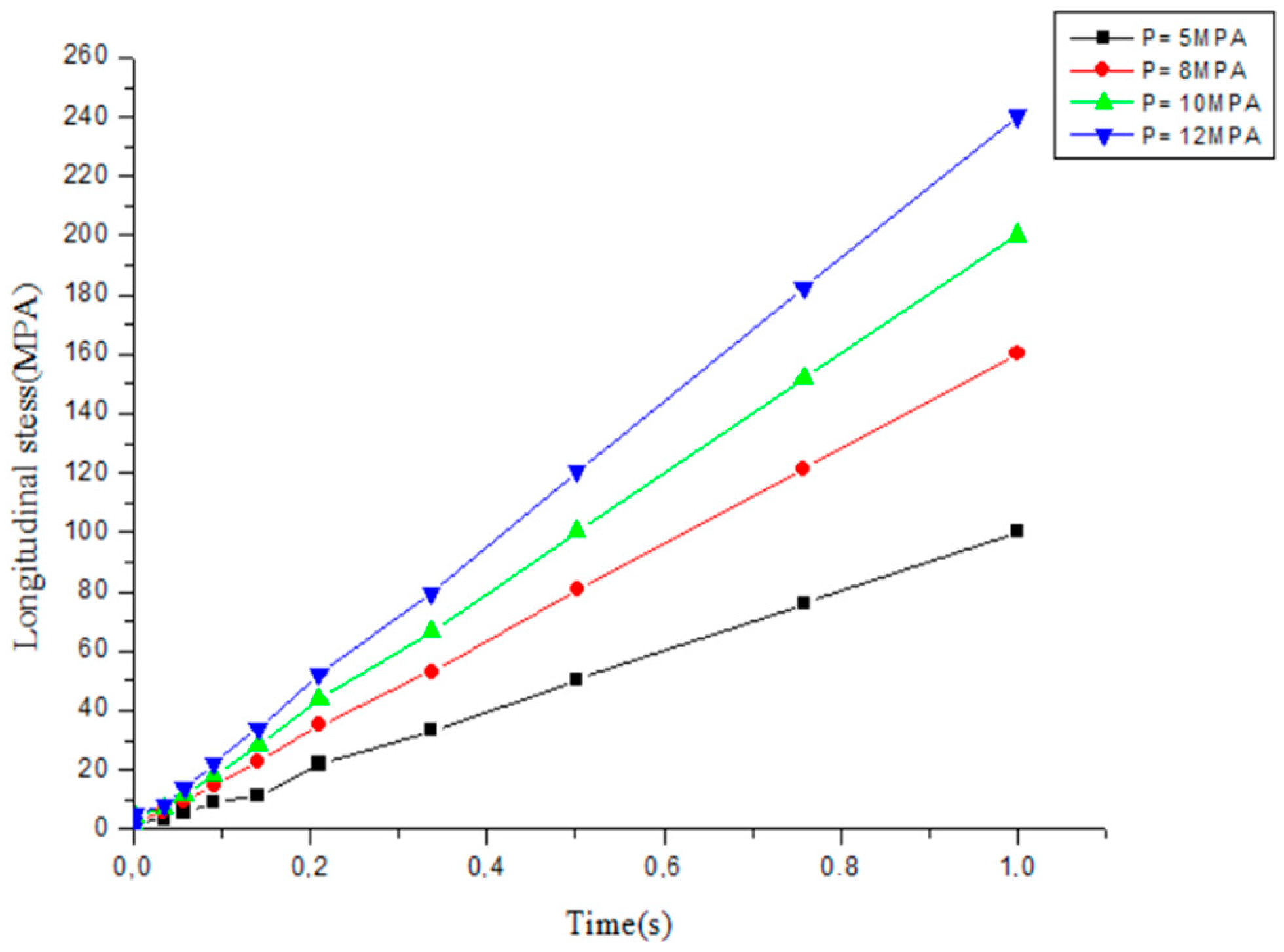

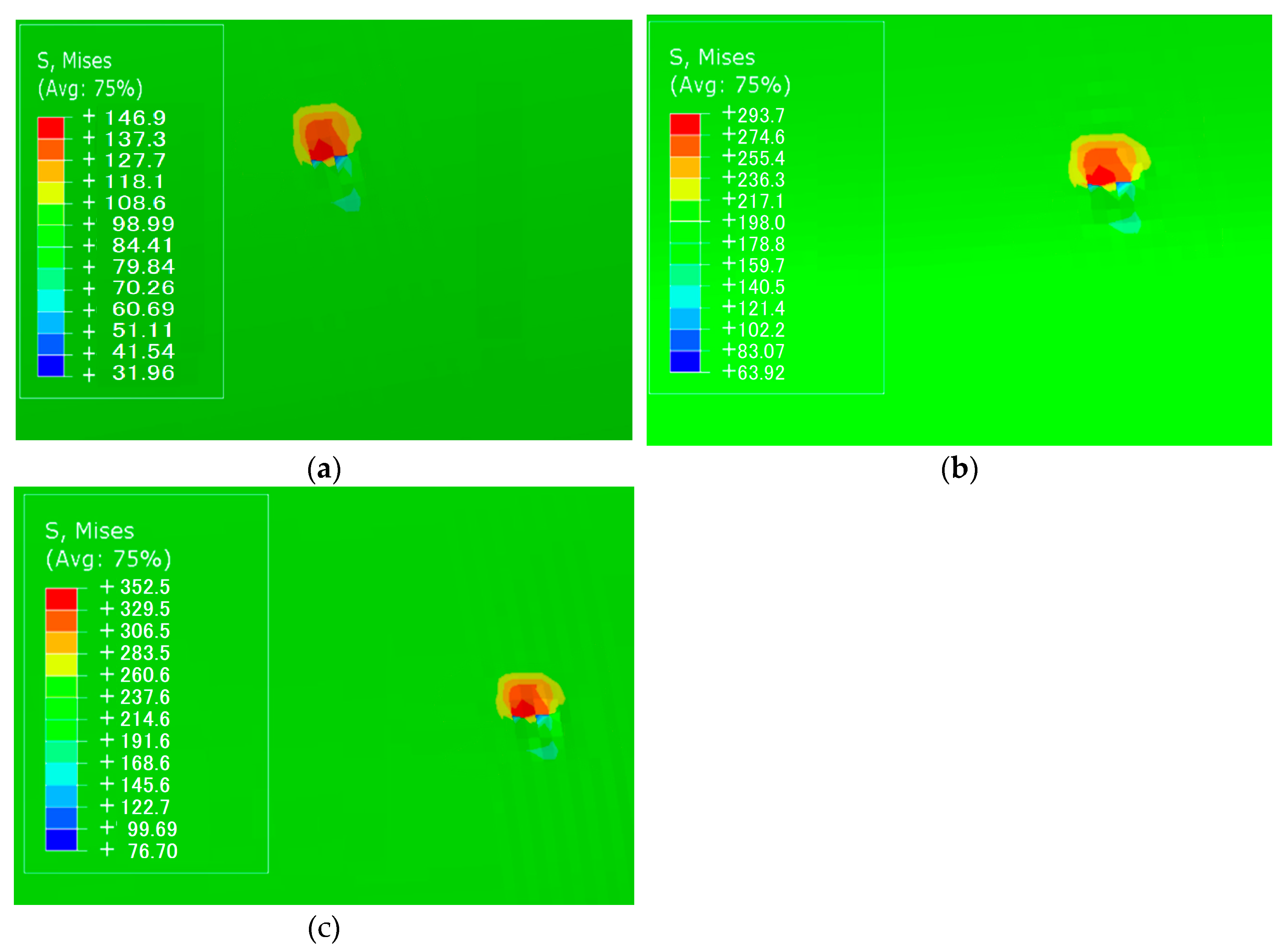
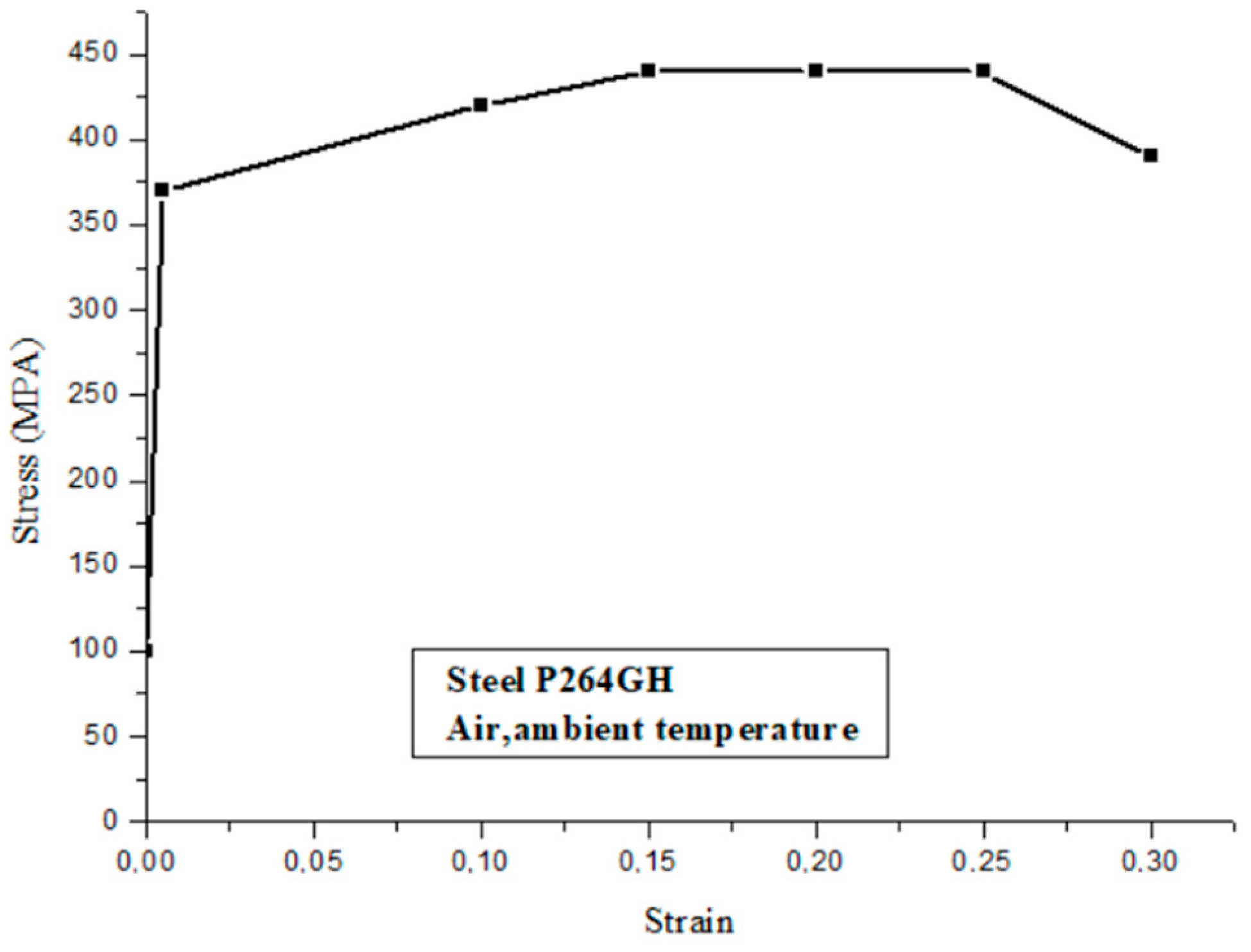

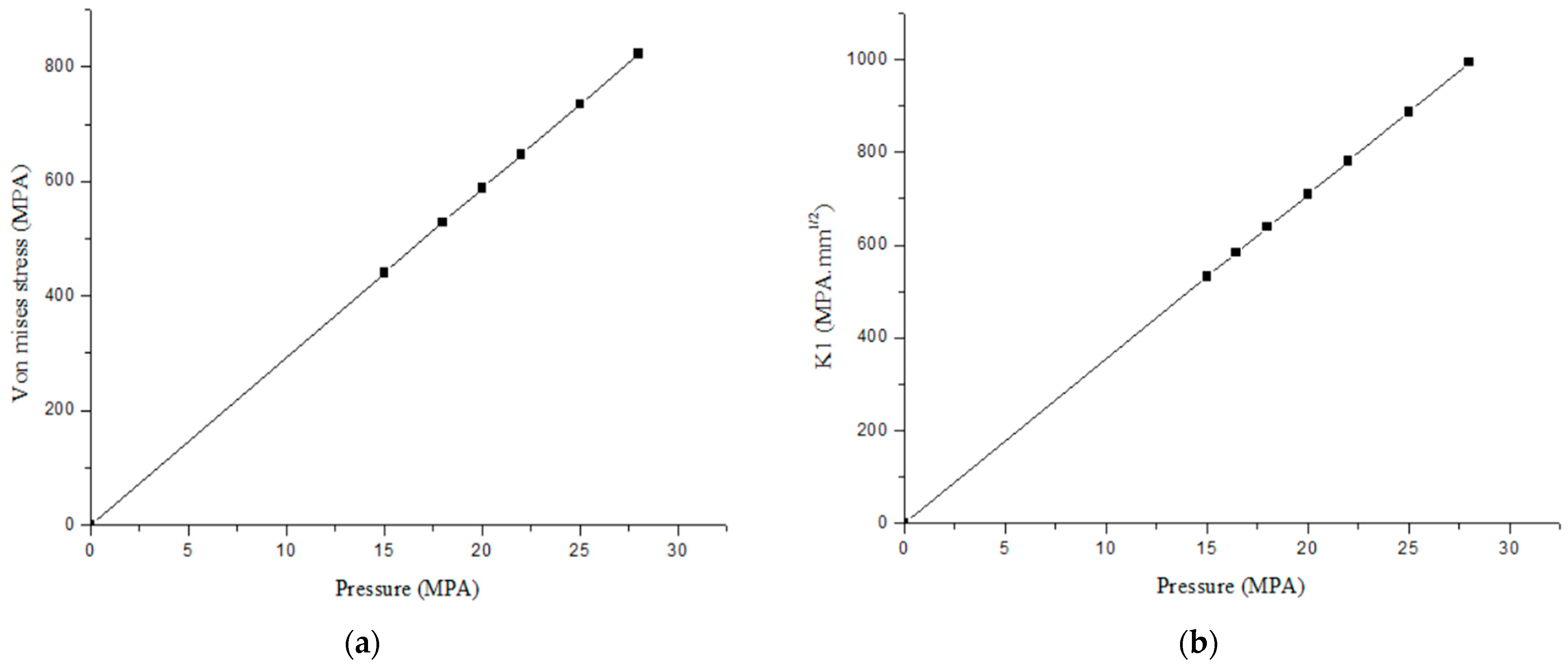

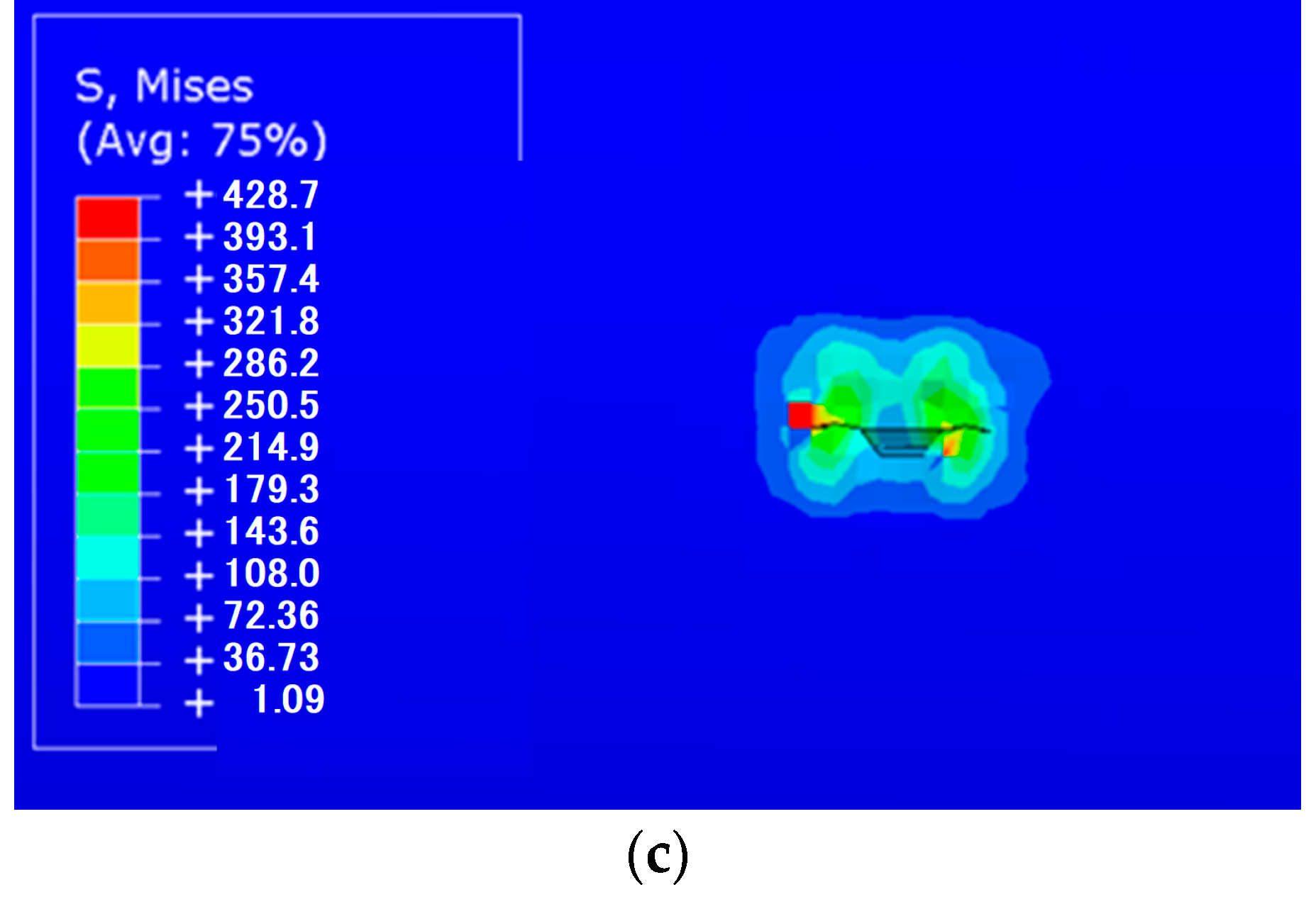


| Year | Researcher | Contribution to XFEM | References |
|---|---|---|---|
| 1996 | Melenk & Babuska | Introduced the Partition of Unity Method (PUM)—foundational concept behind XFEM | Melenk, J. M. & Babuška, I. (1996)—The partition of unity finite element method: Basic theory and applications. Computer Methods in Applied Mechanics and Engineering, 139 (1–4), 289–314 |
| 1999 | Belytschko & Black | First formal definition of XFEM—modeling of cracks without remeshing in 2D linear elasticity | Belytschko, T. & Black, T. (1999). Elastic crack growth in finite elements with minimal remeshing. International Journal for Numerical Methods in Engineering, 45(5), 601–620. |
| 2000 | Moes and al | Introduced the Heaviside function and singular enrichment functions—accurate crack tip representation | Moës, N., Dolbow, J., & Belytschko, T. (1999). A finite element method for crack growth without remeshing. International Journal for Numerical Methods in Engineering, 46(1), 131–150. |
| 2001 | Sukumar and al | Extended XFEM to 3D fracture mechanics and curved crack fronts | Sukumar, N., Chopp, D. L., Moës, N., & Belytschko, T. (2001). Modeling holes and inclusions by level sets in the extended finite-element method. Computer Methods in Applied Mechanics and Engineering, 190(46–47), 6183–6200. |
| 2002 | Moës & Belytschko | Refinement of the cohesive crack model within XFEM, allowing for improved simulation of crack propagation. | Extended finite element method for cohesive crack growth. Engineering Fracture Mechanics, 69(7), 813–833. |
| 2003 | Belytschko & et al. | Development of models for dynamic crack propagation | Belytschko, T., Chen, H., Xu, J., & Zi, G. (2003). Dynamic crack propagation based on loss of hyperbolicity and a new discontinuous enrichment. International Journal for Numerical Methods in Engineering, 58(12), 1873–1905. |
| 2013 | Natarajan, S. & Song | The authors proposed an alternative method to the asymptotic enrichment traditionally used in XFEM to represent the singular fields around crack tip | Natarajan, S., & Song, C. (2013). Representation of singular fields without asymptotic enrichment in the extended finite element method. International Journal for Numerical Methods in Engineering, 96(13), 813–841. |
| 2019 | Swati R.F., et al. | XFEM analysis of crack growth in carbon fiber reinforced composites | Swati, R. F., Wen, L. H., Elahi, H., Khan, A. A., & Shad, S. (2019). Extended finite element method (XFEM) analysis of fiber reinforced composites for prediction of micro-crack propagation and delaminations in progressive damage: a review. Microsystem Technologies, 25(3), 747–763. |
| 2020 | Xu, F., Hajibeygi, H., & Sluys, L. J. | Proposal of a new multiscale formulation for the XFEM, based on local basis functions computed at the fine scale. | Xu, F., Hajibeygi, H., & Sluys, L. J. (2020). Multiscale extended finite element method for deformable fractured porous media. Journal of Computational Physics, 437, 110314 |
| 2022 | Rodríguez-Tembleque & al | Development of a numerical method based on XFEM to simulate electrical resistivity variations caused by the presence of cracks in self-sensing composite materials. | Rodríguez-Tembleque, L., Vargas, J., García-Macías, E., Buroni, F. C., & Sáez, A. (2022). XFEM crack growth virtual monitoring in self-sensing CNT reinforced polymer nanocomposite plates using ANSYS. Composite Structures, 284, 115137. |
| 2023 | Jafari A., Vahab M., Broumand P., Khalili N. | Extension of XFEM in COMSOL 2000. Multiphysics for thermo-hydro-mechanical modeling of discontinuous porous media | Jafari, A., Vahab, M., Broumand, P., & Khalili, N. (2023). An eXtended finite element method implementation in COMSOL multiphysics: Thermo-hydro-mechanical modeling of fluid flow in discontinuous porous media. Computers and Geotechnics, 159, 105458. |
| [mm] | [mm] | a [mm] | 2c [mm] | t [mm] |
|---|---|---|---|---|
| 193.2 | 203.2 | 1 | 10 | 10 |
| Young’s Modulus | Poisson’s Ratio | Yield Stress | Ultimate Tensile Strength | Elongation to Fracture |
|---|---|---|---|---|
| 207 GPA | 0.3 | 340 MPA | 440 MPA | 35% |
| FE | NI | Mn | Si | C |
|---|---|---|---|---|
| 20 | 10.5 | 2 | 1 | 0.08 |
| Mesh Size (mm) | Von Mises Stress (MPA) | Error Indicator |
|---|---|---|
| 5 | 304.2 | 45 |
| 4.5 | 280.5 | 34 |
| 4 | 250.9 | 20 |
| 3.5 | 236.1 | 12 |
| 3 | 209.8 | 0.38 |
| 2.5 | 209.5 | 0.23 |
| 2 | 209.1 | 0.04 |
| 1.5 | 209.1 | 0.04 |
| 1 | 209.1 | 0.04 |
| 0.5 | 209.1 | 0.04 |
| Test Number | P (MPA) | A (mm) | Angular Position/Outer Surface |
|---|---|---|---|
| 1 | 5 | 1 | 0° |
| 2 | 10 | 1 | 0° |
| 3 | 12 | 1 | 0° |
| 4 | 15 | 1 | 0° |
| 5 | 18 | 1 | 0° |
| 6 | 20 | 1 | 0° |
| 7 | 22 | 1 | 0° |
| 8 | 25 | 1 | 0° |
| 9 | 28 | 1 | 0° |
| 10 | 30 | 1 | 0° |
| Hoop Stress | Error Indicator (%) | |
|---|---|---|
| Analytical | 436.05 | 0 |
| H.moustabchir | 435.46 | 0.13 |
| S.montassir | 432.36 | 0.84 |
| XFEM study | 440.4 | 0.99 |
| Parameter | Value |
|---|---|
| E | 207,000 MPA |
| 0.5 | |
| 396 MPA | |
| b | −0.01 |
| c | −0.5 |
| P (MPA) | |
|---|---|
| 5 | 10.89 × 106 cycles |
| 8 | 9.4542 × 104 cycles |
| 10 | 1.016675 × 104 cycles |
| 12 | 1639.19 cycles |
| P (MPA) | |
|---|---|
| 18 | 200 cycles |
| 20 | 3.5 cycles |
| 22 | 1 cycles |
Disclaimer/Publisher’s Note: The statements, opinions and data contained in all publications are solely those of the individual author(s) and contributor(s) and not of MDPI and/or the editor(s). MDPI and/or the editor(s) disclaim responsibility for any injury to people or property resulting from any ideas, methods, instructions or products referred to in the content. |
© 2025 by the authors. Licensee MDPI, Basel, Switzerland. This article is an open access article distributed under the terms and conditions of the Creative Commons Attribution (CC BY) license (https://creativecommons.org/licenses/by/4.0/).
Share and Cite
Barkaoui, A.; El Moussaid, M.; Moustabchir, H.; Vlase, S.; Scutaru, M.L. Fatigue Life Estimation of Pressurized Pipelines Using XFEM: Elastic vs. Plastic Regimes. Symmetry 2025, 17, 1948. https://doi.org/10.3390/sym17111948
Barkaoui A, El Moussaid M, Moustabchir H, Vlase S, Scutaru ML. Fatigue Life Estimation of Pressurized Pipelines Using XFEM: Elastic vs. Plastic Regimes. Symmetry. 2025; 17(11):1948. https://doi.org/10.3390/sym17111948
Chicago/Turabian StyleBarkaoui, Aya, Mohammed El Moussaid, Hassane Moustabchir, Sorin Vlase, and Maria Luminita Scutaru. 2025. "Fatigue Life Estimation of Pressurized Pipelines Using XFEM: Elastic vs. Plastic Regimes" Symmetry 17, no. 11: 1948. https://doi.org/10.3390/sym17111948
APA StyleBarkaoui, A., El Moussaid, M., Moustabchir, H., Vlase, S., & Scutaru, M. L. (2025). Fatigue Life Estimation of Pressurized Pipelines Using XFEM: Elastic vs. Plastic Regimes. Symmetry, 17(11), 1948. https://doi.org/10.3390/sym17111948








